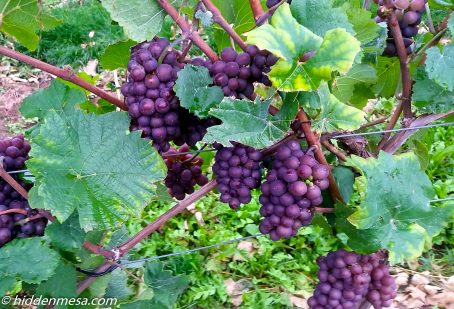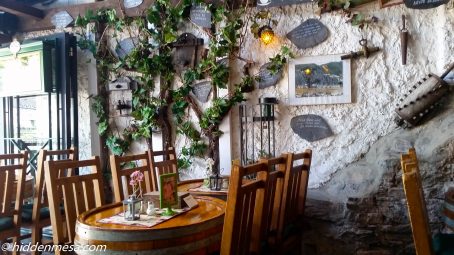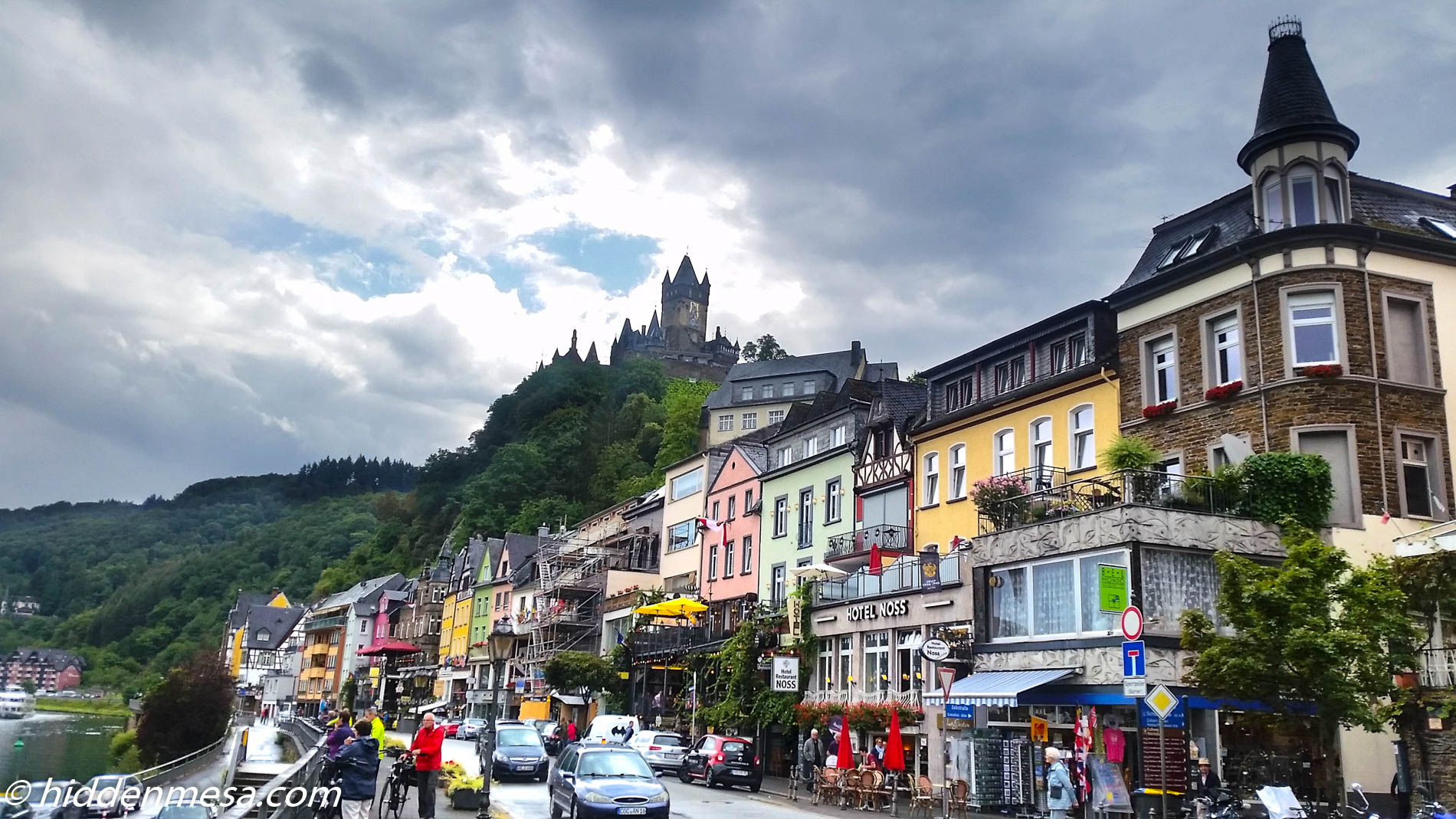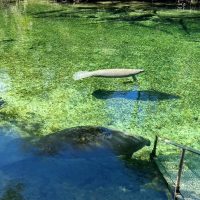There’s a little town called Cochem along the Moselle River, about 20 miles upstream from where the Moselle empties into the Rhine. It’s a German vacation spot, where locals come to camp, play on the river, enjoy some of the local wines, or just hang out in this quaint little town, enjoying the food and shopping.
We discovered this town on our first trip to Germany a few years ago when we were visiting castles, and the local castle, called the Reichsberg Castle, found its way onto our sights. We showed up in this town on a weekend that happened to be a German holiday, and even though we never learned the meaning of the holiday (it seems that everyone would give us a slightly different meaning when we asked), we did learn that the Germans know how to party.
There were literally thousands of German bikers in town on that first trip, along with river cruise ships, and daytime sightseeing ships docked along the river. There were jet skis, kayaks, and yachts cruising up and down the river, and the occasional river-going cargo ship was passing by. Bicycles are a big form of transportation in Europe, and Germans brought their own while the local bicycle rental businesses were doing a brisk business too.
You may find that we use the term Moselle when we’re talking about the River that runs past Cochem, when other folks will say Mosel. Our reasoning is simply that Google Maps calls it Moselle. In France, it’s generally agreed that it’s called the Moselle River. Once it crosses the border into Germany, many locals call it Mosel. Certainly, the wine region is called the Mosel Wine Region and it’s Mosel Wine, not Moselle Wine, that comes from this area. Still, when you’re looking things up on the map, you wouldn’t want to be confused.
This Town Goes Back
We would normally talk about the “old town” when speaking about the touristy parts of any destination in Europe because that’s usually what interests us, but in Cochem, it’s all Old Town. It has its earliest mention in official documents as far back as 886 AD. It was granted “Town Rights” in 1332, presumably by Archbishop Baldwin, who was the Electktor of Trier Territory. The town remained under Trier rule until the French occupation in the 18th Century. From there, it moved forward. There was some damage in World War II with one bombing raid in September of 1942, but most of the town was left standing, and the Castle of course, was not the target.
What to Do In Cochem
Shopping
The first thing we noticed when entering the “tourist” parts of Cochem was the large number of shops. Unlike the usual cafes, bars, and restaurants that you’ll see in a tourist environment, there were also many boutiques and general stores of all kinds. Our first thought was, “we’re never going to get things home if we bought them here,” but the point that this is a German hot spot, catering to local Germans, is underscored. The German tourists can make their purchases, then simply take them to the car and transport them home, again emphasizing the point that this is a German tourist spot.

Wine grapes seem to be the popular crop to row in the Mosel Valley, just upstream of the Rhine River near Cochem. Photo by Bonnie Fink.
Wine
The valley along the Moselle River is a major wine producing area. It seems that every square foot of area capable of agricultural use is engaged in growing wine grapes. We’re not proficient in all the types of wine grapes, but we saw many different varieties during our wanderings through the valley.
The week we arrived at Cochem was the conclusion of their annual Food and Wine Festival. Not to worry, other villages were preparing for their annual Wine events too, and our guess is that pretty much every little village along the Moselle River will be doing a Food and Wine festival of some kind before winter.
Restaurants
There are too many restaurants to count in Cochem. It seems that we would pick one each day more or less at random, and the experience never went bad for us. Language was an issue in most cases, with some servers able to speak a little English, others not so much. It seems like the younger folks were remembering some of their basic English they learned in school, but not much more than that. Still, with our few words of German, a high school course in English on the part of the server, and a trusty Google Translator App to work out the menu, we didn’t go hungry.

One of the many unique restaurants in Cochem, Germany. This establishment seemed to be carved out of a cave in the side of the hill. Photo by Bonnie Fink.
Our favorite café turned out to be a place called Gaststatte Noss. It’s located on the main street of Cochem, about midway through town. We stopped in over the course of several days. Sometimes we’d have coffee, sometimes coffee and dessert, and on one occasion we had a full meal. Everything was perfect for us, and the atmosphere was exactly what we were looking for in a small German village. There was outside seating, inside booths, and our favorite table was actually inside, but inside a glass door that opened to the outside in good weather and closed when it was raining. It was the best for all weather for us. Oh, and the restaurant had free bathrooms for customers. We mention this like it’s unusual in Europe, because it is. We’ll definitely visit again next time we’re in town.
Travelling Around the Area
With so much to offer in this region of the Moselle River, you need a way to get around. For us, we have a leased car, so getting around is as easy as it is any other time. We’re in our comfort zone. The only issue for us is parking once we get to a new village. Most villages we found had either street parking or organized parking lots. For us, arriving at most destinations before noon, parking was not an issue, but we found that parking in some of the busier places like Cochem became a challenge after lunch. Of course, in Cochem, we typically walked from our hotel with the car safely parked there.
The entire region along the Moselle River is connected by a walking and bicycle path on both sides of the river. We saw that many folks used bicycles to move from village to village. Most were locals bringing their own bikes, but we also found a bike rental business on the main street just on the edge of Cochem. Were we into bicycling, this would have made for a pleasant way to travel from the various villages, and parking is less of an issue with this mode of travel.

Bicycles and pedestrians have a separate walking path along the Moselle River in cochem. The pavement on the right is for bicycles while the paving bricks are for walkers. In most places, there is no railing separating the two, You’re on your honor to stay clear of the bicycles. Photo by Donald Fink.
There’s an etiquette involved when it comes to sharing a walking path with bicycles in Cochem. Much of the walking trail is divided into one area that’s paved with black top, and another side that’s paved with concrete pavers. The paver side is for people walking while the smoother black-topped area is for bicycles. It’s best to stick to your side of the trail. Some of those bicycle folks are fast, and the can get up on you very quickly. Pay attention!
River boats are a big item along the Moselle River. Everything goes up and down the river from Viking Cruise Lines to local sunset cruises. Cochem has a couple of small docks with cruises that usually last most of a day, making several stops in other villages before returning to Cochem in the afternoon or evening. We didn’t do a river cruise, but the way the local boats seem to work is they publish a schedule of when they’ll dock at a particular village along their route, then again along their route on the return trip back to Cochem. This means that you can choose to stay with the boat as it makes its way up and down the river, maybe catching some brief shopping at each stop, or you can get off for a longer stay at one village. Maybe have lunch or dinner at one village along the way, then catch the river boat on its return leg to Cochem. Kind of like a hop-on, hop-off bus, except along the river, and worth looking into. Of course, cruise lines like Viking will work all that out for you as well. We know people who have used the Viking Lines in particular and have reported a great experience.
One day cruise operator we saw in Cochem was KD Day Cruises. We can’t recommend them, or not recommend them since we didn’t cruise, but we saw their boats operating from the town. Actually, according to their web site, they have operations all over the area including up and down the Rhine River.
The Castle
You can’t come to Cochem without seeing the Castle. This one is called Schloss Rheichsburg. It sits prominently on the hill directly behind the town of Cochem. There are two ways to get up to the castle: you can walk as we did or you can catch a shuttle bus from the Town Square. We walked, not because we feel the need to punish ourselves, but because we didn’t know about the shuttle until we were already at the top of the hill and we saw a bus go by. Fine!
Tours inside the Reichsburg Castle are guided, meaning that you can’t just wander the halls. But there was plenty of time to stop and take it all in and take photos. The tour guides offered several different languages with their tours too. On a previous visit, we discovered a lighting fixture in the castle that’s supposedly a mermaid, and according to the tour guide, touching the mermaid would bring about good luck. At the time our house in New Mexico had an offer pending. It was the only credible offer we had seen in seven years on this property, so you can imagine that we couldn’t pass up the opportunity to make contact with the lucky-mermaid-lighting-fixture-thing. And of course, the house closed shortly after and we went about our merry lives. Hooray for the lucky Mermaid!
Where to stay
We stayed at the Stumberger Hotel located just outside the village along the Moselle River. We’ve made two trips to Cochem and stayed there both times and couldn’t be happier. If we return to Cochem—and we certainly will—we’ll stay there again. We feel so strongly in our recommendation about Stumbergers Hotel that we posted a separate article about it here. It reads a bit like a commercial advertisement, but it was just a great place to stay.
There are indeed dozens, if not hundreds of hotels located in and around the Cochem area, and most of them would probably be good choices. We’ve only stayed at Stumberger’s so we can’t recommend the others, but we’re sure you can do your own homework if you plan a visit to Cochem.
One possible reason for staying somewhere else is that Stumberger’s is on the very edge of town. It takes a bit of a walk to get into the city center. We happen to enjoy walking, so it worked as an advantage for us. You may not feel the same and prefer a room in the center where your favorite café is right outside your door. It’s certainly possible in Cochem.
Our overall impression of Cochem is that it is a great place to come and play. It’s also primarily a place where Germans come. We’re not usually all that interested in where the “locals” hang out, but in the case of Germany, it seems appropriate. The Germans, for the most part, seem to like the same things we do. Good food, good drink, recreational opportunities all around. What’s to go wrong? And in Cochem, we found all that and more. After two visits, we’re sure it will be on our list in future visits too. Cochem has become our German home town.










Hello
I have reason to think your information about the bombing raid of Sept. 1942 may not be correct. Im a historian and am extremely interested to find out where you got this information from? I dont see in documents that Cochem was ever a target for the RAF, and the USAAF were not operational into Germany at that time.
I suspect you are following from a report of a RAF Lancaster bomber that crashed into the woods near to the top and right several hundred meters, of the chair lift summit, north west of the town, around 3am Sept 20th 1942. If so, this was not an attack on Cochem but a crippled 61 Squadron RAF bomber piloted by my Uncle – Robert Owen, RAAF (Australia) crewed by Australians and Canadians – hit by flack during their earlier raid on Munich on its return leg to RAF Syerston airbase UK. All 7 of the crew were killed when it fell into the woods. Below is a link to the photo in the German national archive taken by Herbert Ahrens – a local perhaps?
https://commons.wikimedia.org/wiki/File:Bundesarchiv_Bild_146-1975-062-30,_Abgeschossener_britischer_Bomber.jpg
aircraft – Lancaster W4166 – broken up in the trees in the steep bank of the west side. All 7 crew were buried in one of the Cochem church yards (which one?) then exhumed in 1949 and re-buried at Rhineburg Commonwealth War Graves cemetery.
Im very interested as the local reports of this incident may lead me to further photographs. My wife and I will be visiting and staying in Cochem in June this year 2018 – for 3 days.
Regards
David Owen
Sydney, Australia
Hi David,
Thanks for your comments. I write these articles quickly and sometimes don’t keep accurate notes. The articles are intended mostly for entertainment, and as a result, might be a little relaxed in terms of their accuracy.
Having said that, I do see that Cochem was bombed at least twice during World War II. The first bombing allegedly occurred on September 16, 1942 as part of a campaign by the RAF against what was called the Ruhr Industrial Region. Several cities were bombed that night, including Essen, Bochum, Wuppertal, Heme, and Cochem.
https://ww2db.com/battle_spec.php?battle_id=55
I’m just guessing, but this was probably an attack on the Bosch plant located in Cochem that manufactured spark plugs, ignition systems, and glow plugs, allegedly using slave labor. The slave labor was from the Natzweiler concentration camp. Apparently there was a sub-camp in or near Cochem that had 13,000 prisoners.
A second attack is reported to have occurred in early 1945, but the only evidence I have of this is a single statement on a web site discussing German Synagogues and communities that were destroyed. It claims that a Synagogue was destroyed by an air raid, but gives no further details.
http://www.germansynagogues.com/index.php/synagogues-and-communities?pid=67&sid=340:cochem
This information, of course, is beyond the point of the article, which was intended to showcase Cochem as a great little German town, where Germans and tourists from all over the world come to enjoy a few days wandering the city and enjoying the river front.
We still have fond memories of Cochem. We’ve been there twice, and will likely return in the future.
By the way, English was not as prevalent there as it is in larger German cities. Everyone knew a little “high school” English, but it would be a good idea to brush up on your coffee ordering skills in German before you go. Our German language skills are generally poor, but the people were friendly, and we were able to work things out.
Enjoy tour trip.
Hello Again Donald.
We had a wonderful week in Cochem at the end of June 2018 and met Walter Schmitz the Mayor. I explained about my uncles Lancaster bomber and he searched the town archives and upon returning the next day we were shown some new evidence. Walter put us in contact with a local history group who were also researching the fate of W4166. Remarkably there is still living an eye witness to the event who saw the bomber coming down chased by a Luftwaffe night fighter. He was able to explain why the aircraft was reported as crashing in two different places, as it had broken into two just prior to hitting the top of the mountain. The rear fuselage ended where the camp ground is today and the forward section and wings a few hundred meters further up on the other side of the main road just above a old manor house called the Winterhaus in the Feitsch. We were also shown the Catholic cemetery where the crew were interned and it was recorded they were given a ceremony. The brutal side of the war being put aside. Some relics of the plane have been recovered Etc.
The people we met were always friendly and with the great outdoor atmosphere that Cochem has, we will be returning – next time with our bicycles –
Hi David,
Let me apologize for taking so long to reply. We began our summer vacation, traveling around the Rocky Mountains just after you made this comment, and in the turmoil of getting ready and so on, I simply forgot.
I’m glad you had a good time this last visit in Cochem. Next time we go, I’ll be sure and re-trace some of the things you did and see what I can find. Bonnie and I are learning German, and hopefully will be able to have at least basic conversations one day.
I’ll reach out (if I can remember) before I go to Cochem again and see if there’s anything you need me to check out, but it looks like you learned quite a bit on your last trip.